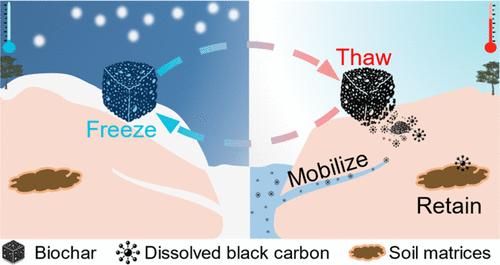当前位置:
X-MOL 学术
›
Environ. Sci. Technol.
›
论文详情
Our official English website, www.x-mol.net, welcomes your
feedback! (Note: you will need to create a separate account there.)
Freeze–Thaw Cycle Events Enable the Deep Disintegration of Biochar: Release of Dissolved Black Carbon and Its Structural-Dependent Carbon Sequestration Capacity
Environmental Science & Technology ( IF 10.8 ) Pub Date : 2024-11-14 , DOI: 10.1021/acs.est.4c07262 Lang Zhu, Na Chen, Xianglei Zhang, Luyao Ren, Rui Zou, Jia Xie, Zhiqiang Wang, Huiqiang Yang, Zelin Hao, Jianjun Qin, Hanzhong Jia
Environmental Science & Technology ( IF 10.8 ) Pub Date : 2024-11-14 , DOI: 10.1021/acs.est.4c07262 Lang Zhu, Na Chen, Xianglei Zhang, Luyao Ren, Rui Zou, Jia Xie, Zhiqiang Wang, Huiqiang Yang, Zelin Hao, Jianjun Qin, Hanzhong Jia

|
Biochar is widely regarded as a recalcitrant carbon pool. However, the impact of freeze–thaw cycle events on its storage capacity, particularly on the release of dissolved black carbon (DBC), has remained poorly investigated. This study investigated the release behavior of DBC from biochar pyrolyzed at 300–700 °C during freeze–thaw cycles and their retention capacity in soil. Freeze–thaw cycles dramatically promoted DBC release (33.08–230.74 mg C L–1), exhibiting an order of magnitude higher than those without freeze–thaw process. The release kinetics of freeze–thaw-induced DBC varied depending on the pyrolysis temperature of biochar due to the different disintegration mechanisms. Interestingly, the retention capacity of freeze–thaw-induced DBC in soil showed a reduction ranging from 7.7 to 29.5% compared to DBC without the freeze–thaw process. This reduction can be attributed to numerous hydrophilic low-molecular-weight compounds (16.97–75.31%) in freeze–thaw-induced DBC, as evidenced by the results of size exclusion chromatography, fluorescence excitation/emission matrix, Fourier transform infrared spectroscopy, and nuclear magnetic resonance. These compounds tend to concentrate in the aqueous phase rather than being retained in the soil, potentially exacerbating the outflow of dissolved organic carbon. These findings clarify the release behavior of DBC during freeze–thaw cycles and reveal their contribution to the attenuation of carbon pools in cold regions.
中文翻译:

冻融循环事件使生物炭能够深度分解:释放溶解的黑碳及其结构依赖性的碳封存能力
生物炭被广泛认为是一个顽固的碳库。然而,冻融循环事件对其存储容量的影响,特别是对溶解黑碳 (DBC) 释放的影响,仍然研究不足。本研究调查了冻融循环期间在 300–700 °C 热解生物炭中 DBC 的释放行为及其在土壤中的保留能力。冻融循环显着促进了 DBC 的释放 (33.08–230.74 mg C L–1),表现出比没有冻融过程的释放高一个数量级。由于崩解机制不同,冻融诱导的 DBC 的释放动力学随生物炭的热解温度而变化。有趣的是,与没有冻融过程的 DBC 相比,冻融诱导的 DBC 在土壤中的保留能力降低了 7.7% 至 29.5%。这种降低可归因于冻融诱导的 DBC 中许多亲水性低分子量化合物 (16.97–75.31%),尺寸排阻色谱、荧光激发/发射矩阵、傅里叶变换红外光谱和核磁共振的结果证明了这一点。这些化合物往往集中在水相中,而不是保留在土壤中,这可能会加剧溶解有机碳的流出。这些发现阐明了 DBC 在冻融循环过程中的释放行为,并揭示了它们对寒冷地区碳库衰减的贡献。
更新日期:2024-11-15
中文翻译:

冻融循环事件使生物炭能够深度分解:释放溶解的黑碳及其结构依赖性的碳封存能力
生物炭被广泛认为是一个顽固的碳库。然而,冻融循环事件对其存储容量的影响,特别是对溶解黑碳 (DBC) 释放的影响,仍然研究不足。本研究调查了冻融循环期间在 300–700 °C 热解生物炭中 DBC 的释放行为及其在土壤中的保留能力。冻融循环显着促进了 DBC 的释放 (33.08–230.74 mg C L–1),表现出比没有冻融过程的释放高一个数量级。由于崩解机制不同,冻融诱导的 DBC 的释放动力学随生物炭的热解温度而变化。有趣的是,与没有冻融过程的 DBC 相比,冻融诱导的 DBC 在土壤中的保留能力降低了 7.7% 至 29.5%。这种降低可归因于冻融诱导的 DBC 中许多亲水性低分子量化合物 (16.97–75.31%),尺寸排阻色谱、荧光激发/发射矩阵、傅里叶变换红外光谱和核磁共振的结果证明了这一点。这些化合物往往集中在水相中,而不是保留在土壤中,这可能会加剧溶解有机碳的流出。这些发现阐明了 DBC 在冻融循环过程中的释放行为,并揭示了它们对寒冷地区碳库衰减的贡献。


















































 京公网安备 11010802027423号
京公网安备 11010802027423号